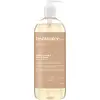What's inside
What's inside
 Key Ingredients
Key Ingredients

 Benefits
Benefits

 Concerns
Concerns

 Ingredients Side-by-side
Ingredients Side-by-side

Water
Skin ConditioningAloe Barbadensis Leaf Juice
Skin ConditioningCocamidopropyl Betaine
CleansingDecyl Glucoside
CleansingPEG-150 Pentaerythrityl Tetrastearate
EmulsifyingGlycerin
HumectantRosa Canina Fruit Oil
EmollientSimmondsia Chinensis Seed Oil
EmollientPersea Gratissima Oil
Skin ConditioningTocopherol
AntioxidantGlycine Soja Oil
EmollientChamomilla Recutita Flower Extract
MaskingYucca Schidigera Root Extract
Skin ConditioningLavandula Angustifolia Flower Extract
CleansingCitrus Tangerina Peel Oil
MaskingCitrus Nobilis Peel Oil
MaskingLavandula Angustifolia Oil
MaskingVanillin
MaskingVanilla Planifolia Fruit Extract
Skin ConditioningPhenoxyethanol
PreservativeBenzyl Alcohol
PerfumingLimonene
PerfumingLinalool
PerfumingWater, Aloe Barbadensis Leaf Juice, Cocamidopropyl Betaine, Decyl Glucoside, PEG-150 Pentaerythrityl Tetrastearate, Glycerin, Rosa Canina Fruit Oil, Simmondsia Chinensis Seed Oil, Persea Gratissima Oil, Tocopherol, Glycine Soja Oil, Chamomilla Recutita Flower Extract, Yucca Schidigera Root Extract, Lavandula Angustifolia Flower Extract, Citrus Tangerina Peel Oil, Citrus Nobilis Peel Oil, Lavandula Angustifolia Oil, Vanillin, Vanilla Planifolia Fruit Extract, Phenoxyethanol, Benzyl Alcohol, Limonene, Linalool
Water
Skin ConditioningCoco-Glucoside
CleansingCocamidopropyl Betaine
CleansingSodium Coco-Sulfate
CleansingHoney
HumectantVanilla Planifolia Fruit Extract
Skin ConditioningButyrospermum Parkii Butter
Skin ConditioningOlea Europaea Fruit Oil
MaskingCocos Nucifera Oil
MaskingGlycerin
HumectantTocopherol
AntioxidantPolysorbate 80
EmulsifyingPotassium Sorbate
PreservativeSodium Benzoate
MaskingSodium Chloride
MaskingTetrasodium Glutamate Diacetate
Citric Acid
BufferingWater, Coco-Glucoside, Cocamidopropyl Betaine, Sodium Coco-Sulfate, Honey, Vanilla Planifolia Fruit Extract, Butyrospermum Parkii Butter, Olea Europaea Fruit Oil, Cocos Nucifera Oil, Glycerin, Tocopherol, Polysorbate 80, Potassium Sorbate, Sodium Benzoate, Sodium Chloride, Tetrasodium Glutamate Diacetate, Citric Acid
Ingredients Explained
These ingredients are found in both products.
Ingredients higher up in an ingredient list are typically present in a larger amount.
Cocamidopropyl Betaine is a fatty acid created by mixing similar compounds in coconut oil and dimethylaminopropylamine, a compound with two amino groups.
This ingredient is a surfactant and cleanser. It helps gather the dirt, pollutants, and other impurities in your skin to be washed away. It also helps thicken a product and make the texture more creamy.
Being created from coconut oil means Cocamidopropyl Betaine is hydrating for the skin.
While Cocamidopropyl Betaine was believed to be an allergen, a study from 2012 disproved this. It found two compounds in unpure Cocamidopropyl Betaine to be the irritants: aminoamide and 3-dimethylaminopropylamine. High-grade and pure Cocamidopropyl Betaine did not induce allergic reactions during this study.
Learn more about Cocamidopropyl BetaineGlycerin is already naturally found in your skin. It helps moisturize and protect your skin.
A study from 2016 found glycerin to be more effective as a humectant than AHAs and hyaluronic acid.
As a humectant, it helps the skin stay hydrated by pulling moisture to your skin. The low molecular weight of glycerin allows it to pull moisture into the deeper layers of your skin.
Hydrated skin improves your skin barrier; Your skin barrier helps protect against irritants and bacteria.
Glycerin has also been found to have antimicrobial and antiviral properties. Due to these properties, glycerin is often used in wound and burn treatments.
In cosmetics, glycerin is usually derived from plants such as soybean or palm. However, it can also be sourced from animals, such as tallow or animal fat.
This ingredient is organic, colorless, odorless, and non-toxic.
Glycerin is the name for this ingredient in American English. British English uses Glycerol/Glycerine.
Learn more about GlycerinTocopherol (also known as Vitamin E) is a common antioxidant used to help protect the skin from free-radicals and strengthen the skin barrier. It's also fat soluble - this means our skin is great at absorbing it.
Vitamin E also helps keep your natural skin lipids healthy. Your lipid skin barrier naturally consists of lipids, ceramides, and fatty acids. Vitamin E offers extra protection for your skin’s lipid barrier, keeping your skin healthy and nourished.
Another benefit is a bit of UV protection. Vitamin E helps reduce the damage caused by UVB rays. (It should not replace your sunscreen). Combining it with Vitamin C can decrease sunburned cells and hyperpigmentation after UV exposure.
You might have noticed Vitamin E + C often paired together. This is because it is great at stabilizing Vitamin C. Using the two together helps increase the effectiveness of both ingredients.
There are often claims that Vitamin E can reduce/prevent scarring, but these claims haven't been confirmed by scientific research.
Learn more about TocopherolVanilla Planifolia Fruit Extract comes from the vanilla orchid native to central America. It is a skin-soothing ingredient.
This ingredient is skin-soothing and contains polyphenols that give it antioxidant properties.
This ingredient is not known to sensitize or irritate skin (unlike Vanilla Tahitensis). Vanilla tahitensis has shown to irritate skin in low amounts.
Learn more about Vanilla Planifolia Fruit ExtractWater. It's the most common cosmetic ingredient of all. You'll usually see it at the top of ingredient lists, meaning that it makes up the largest part of the product.
So why is it so popular? Water most often acts as a solvent - this means that it helps dissolve other ingredients into the formulation.
You'll also recognize water as that liquid we all need to stay alive. If you see this, drink a glass of water. Stay hydrated!
Learn more about Water